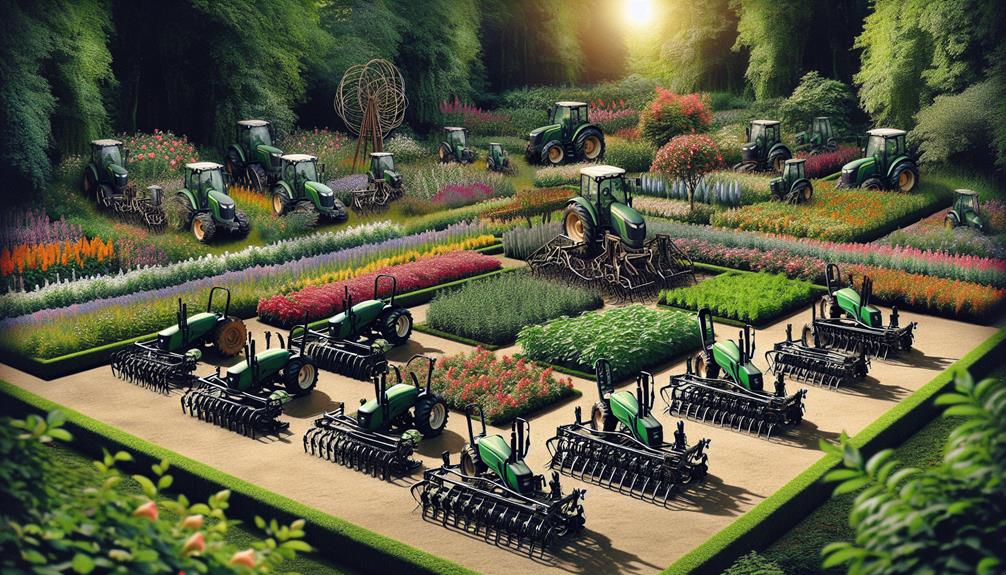When it comes to achieving flawless garden beds, having the right cultivator or tiller can make all the difference. Imagine effortlessly transforming even the toughest soil into a pristine planting surface with just the push of a button or a simple maneuver.
But which of these top 5 cultivators and tillers will truly elevate your gardening game? Stay tuned to uncover the key features and benefits that set these tools apart, guiding you towards the perfect choice for your garden beds.
Key Takeaways
- Lightweight cultivators with adjustable handles offer easy maneuverability for perfecting garden beds.
- Choose cultivators based on soil type and texture for optimal results.
- Prioritize durability with rust-resistant materials and regular maintenance for long-term performance.
- Consider motor power, tine configuration, and cultivation width for efficient garden bed preparation.
Rotary Cultivator Garden Tiller with Adjustable Stainless Steel Poles
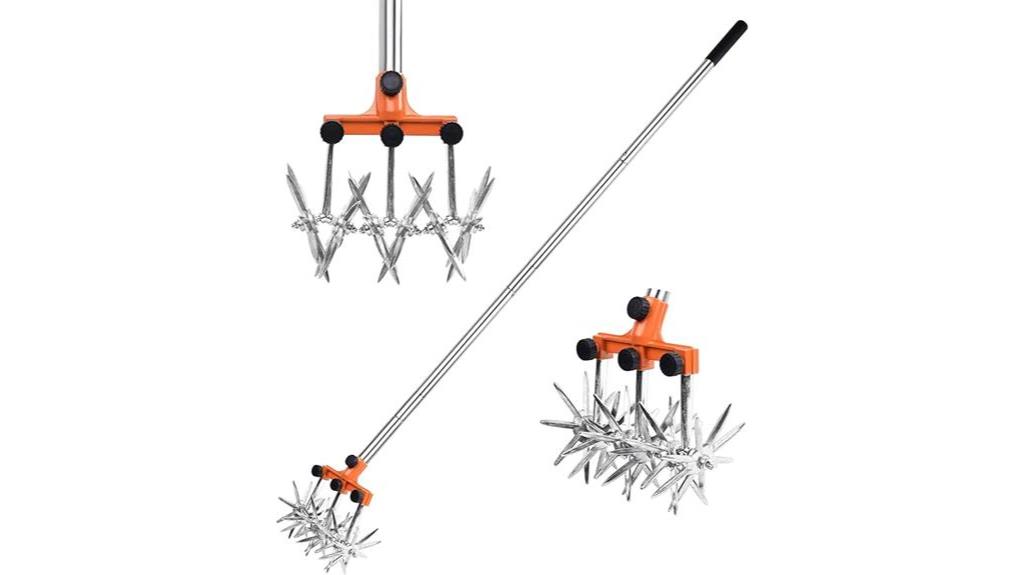
For those tending to raised bed gardens or working in small areas, the Rotary Cultivator Garden Tiller with Adjustable Stainless Steel Poles offers a lightweight and efficient solution for aerating and cultivating soil. This cultivator features durable anti-rust aluminum tines and high-quality stainless steel handle poles, ensuring a comfortable grip while working. The adjustable handle poles allow for a customized working length, making it easy to assemble and use. Measuring 8 x 5.3 x 57 inches and weighing only 3.01 pounds, this cultivator is designed for easy maneuverability in tight spaces.
While it excels at breaking hard topsoil and tilling the ground, it isn't specifically designed for heavy workloads or large areas. The Rotary Cultivator Garden Tiller is a great choice for those seeking a reliable tool for small-scale gardening tasks.
Best For: Small-scale gardeners or individuals tending to raised bed gardens in need of a lightweight and efficient soil cultivating tool.
Pros:
- Lightweight design for easy maneuverability in small areas.
- Durable construction with anti-rust aluminum tines and high-quality stainless steel handle poles.
- Adjustable handle poles for a customized working length, comfortable grip, and easy assembly.
Cons:
- Not suitable for heavy workloads or large areas.
Sun Joe TJ603E 16-Inch 12-Amp Electric Tiller and Cultivator , Green
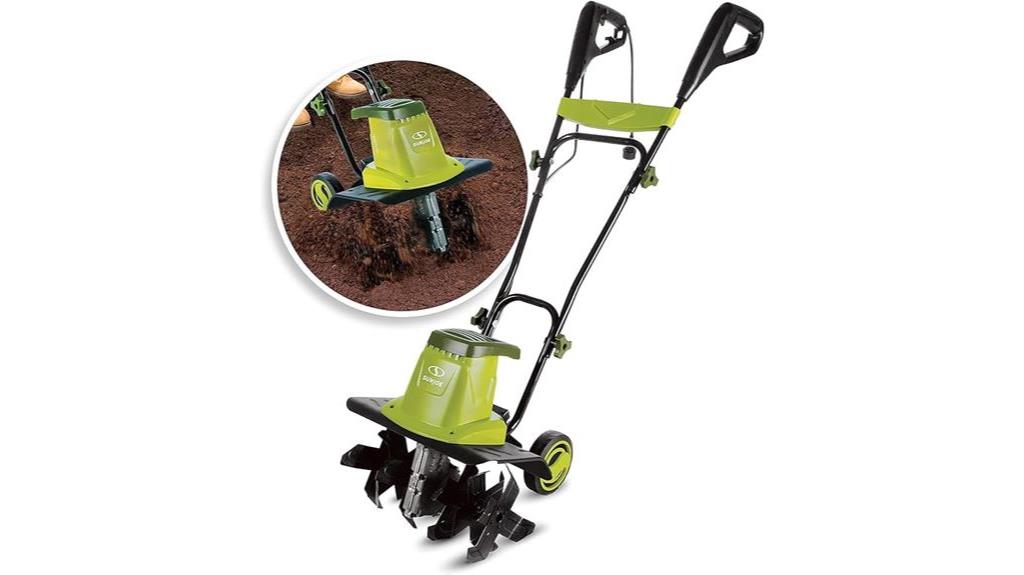
Ideal for gardeners seeking a lightweight and efficient solution for breaking through tough soil and controlling weeds, the Sun Joe TJ603E 16-Inch 12-Amp Electric Tiller and Cultivator in Green offers a powerful and user-friendly gardening tool.
With durable 6 steel angled tines, it ensures maximum performance and durability. The 12-amp motor operates at 340 RPM, allowing you to cultivate a 16-inch wide and up to 8-inch deep area quickly. This electric tiller is praised for its easy maneuverability, user-friendly controls, and adjustable handlebar height. While some users faced challenges with soil clogging, overall feedback highlights its efficiency in gardening tasks.
Lightweight, easy to assemble, and suitable for average home garden needs, the Sun Joe TJ603E is a great choice for maintaining your garden beds.
Best For: Home gardeners looking for a lightweight and efficient solution for breaking through tough soil and controlling weeds.
Pros:
- Durable 6 steel angled tines for maximum performance and durability
- Powerful 12-amp motor operates at 340 RPM for efficient soil preparation
- Lightweight and easy to maneuver, suitable for average home garden needs
Cons:
- Some challenges with soil clogging between tines and wheels
Walensee Rotary Cultivator Tool with Stainless Steel Pole
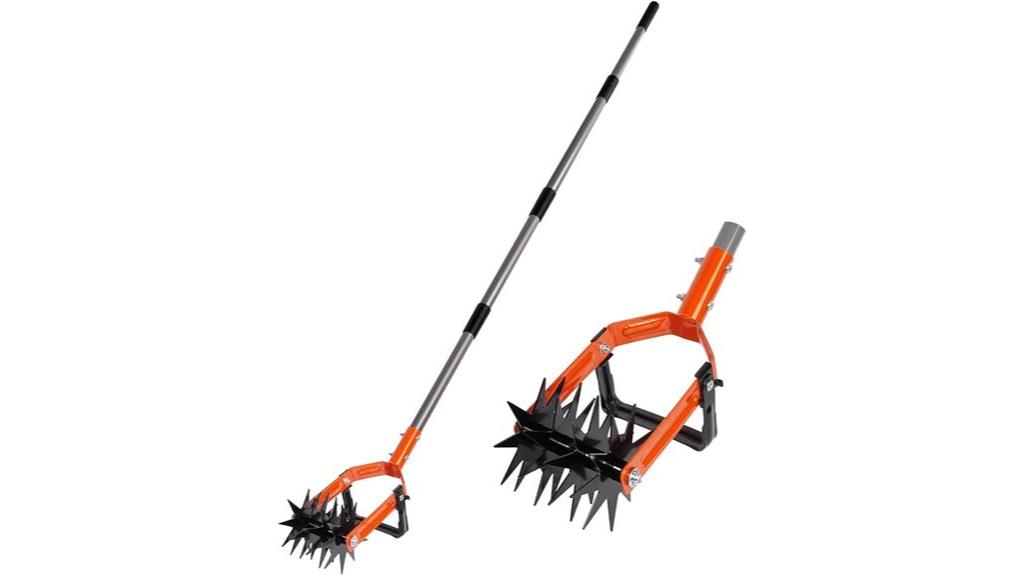
With its unique star-shaped head and durable stainless steel pole, the Walensee Rotary Cultivator Tool is designed for gardeners seeking an efficient solution for breaking soil and weeding with ease. This 2-in-1 garden tool features a weeding knife made of manganese steel with hardened treatment, ensuring durability for tasks like decompressing hardened earth and pulling weeds. The adjustable handle with an ergonomic design reduces hand strain, while the corrosion-proof and rust-resistant stainless steel pole adds to its longevity.
While some users found it effective for light soils, feedback suggests it may be less efficient on heavy or clay soils. Consider this tool for young weeds in loose to mildly firm soil, keeping in mind the need for strength and time for optimal results.
Best For: Gardeners looking to efficiently break soil and weed with ease, particularly for light soils and young weeds.
Pros:
- 2-in-1 tool for weeding and soil cultivation.
- Durable stainless steel construction.
- Adjustable ergonomic handle for reduced hand strain.
Cons:
- May be less effective on heavy or clay soils.
Fiskars Telescoping Rotary Cultivator (40-60 Extendable)
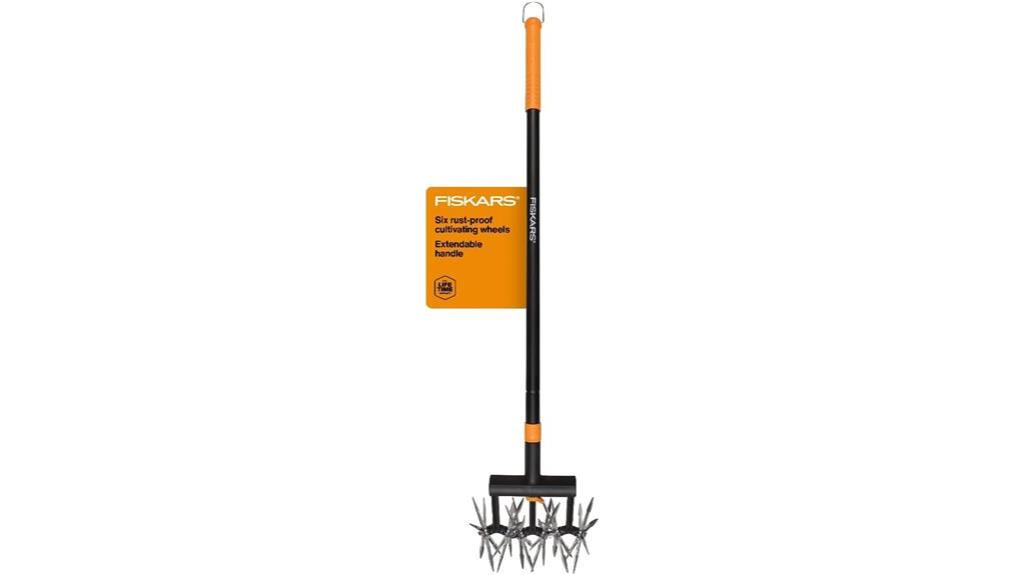
When considering cultivators and tillers for garden beds, the Fiskars Telescoping Rotary Cultivator stands out for its ergonomic design and versatile functionality, making it a top choice for avid gardeners seeking efficiency and durability.
This cultivator extends from 40 to 60 inches, offering a lightweight all-steel pole that's perfect for aerating and cultivating tough soil. The FiberComp head with six aluminum wheels ensures durability, while the ergonomic handle design provides comfortable use during long gardening sessions.
Rust-proof aluminum cultivating wheels further enhance its longevity, making it suitable for weeding, tilling, and aerating garden beds with ease. Backed by smart technologies and a full lifetime warranty, the Fiskars Telescoping Rotary Cultivator is a reliable tool for maintaining your garden beds.
Best For: Gardeners looking for a versatile and durable cultivator that can efficiently aerate and cultivate tough soil in garden beds.
Pros:
- Lightweight all-steel pole for easy handling.
- Ergonomic handle design for comfortable use during long gardening sessions.
- Rust-proof aluminum cultivating wheels for enhanced durability.
Cons:
- May require additional tools for obstacles like rocks and roots.
BILT HARD Electric Garden Rototiller (16 inch, 13.5 Amp)
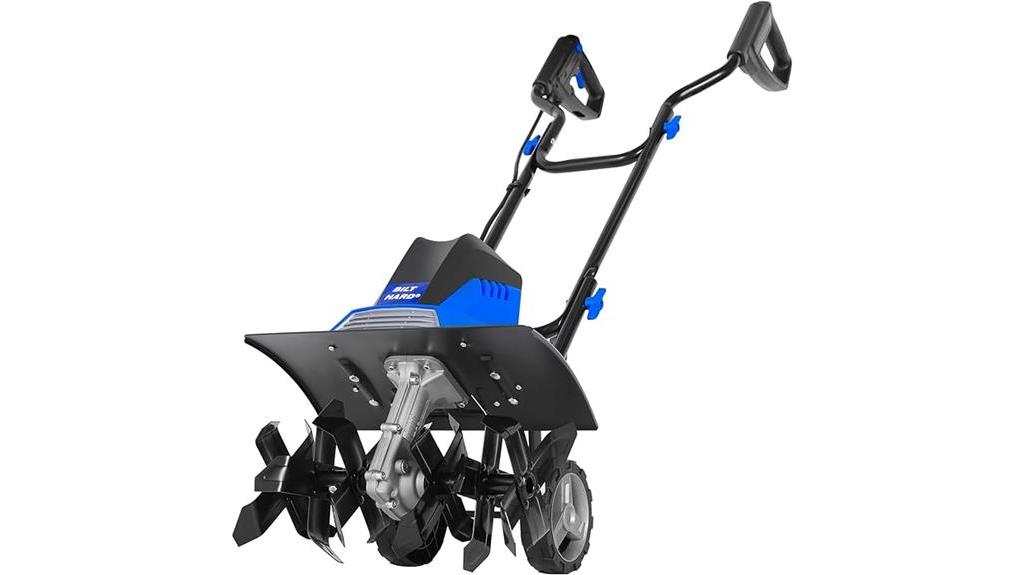
Suitable for small to medium gardens, lawns, and flowerbeds, the BILT HARD Electric Garden Rototiller offers powerful performance in a lightweight and efficient design. With a robust AC motor reaching speeds up to 19,000RPM, this tiller can cultivate areas up to 16 inches wide and 8.7 inches deep. Equipped with six rust-resistant blades operating at a maximum speed of 360RPM, it efficiently loosens soil, removes weeds, and blends compost. The rototiller features foldable handles for easy storage and transport, along with six adjustable wheels for convenient maneuverability.
While it handles regular soil adeptly, heavy grass roots may pose a slight challenge, although manageable. Overall, this electric garden rototiller delivers durability, power, and ease of use for various gardening tasks.
Best For: Small to medium garden owners looking for a lightweight and efficient rototiller for regular soil maintenance.
Pros:
- Powerful AC motor with high RPM for effective cultivation
- Lightweight and easy to handle for various gardening tasks
- Foldable handles and adjustable wheels for convenient storage and maneuverability
Cons:
- May struggle with heavy grass roots
Factors to Consider When Choosing Cultivators & Tillers
When choosing cultivators and tillers, it's important to consider key features like power source and size.
Soil compatibility is crucial, ensuring the machine can handle the specific type of soil in your garden.
Additionally, durability, maintenance requirements, and a user-friendly design are essential factors to keep in mind.
Factors to Consider
Considering the size of your gardening area is crucial when selecting the right cultivator or tiller for your needs. The width and depth of the machine should match the size of your garden beds to ensure efficient soil cultivation.
Adjustable handle lengths are essential for ergonomic use, reducing strain on your arms and back. When choosing between electric, gas, or manual cultivators, consider both your preference and the garden's size.
Evaluate the number and type of tines or blades on the cultivator to ensure effective soil turning and weed removal. Lastly, don't forget to check the warranty and customer support provided with the cultivator to guarantee product quality and durability.
Key Features
In selecting cultivators & tillers for your garden beds, prioritize key features like the power source, tilling capacity, blade configuration, and handle design.
The power source (electric, gas, manual) determines the convenience and efficiency of the tool. Consider the tilling width and depth capacity to match your garden's needs.
The number of tines or blades affects the cultivator's ability to break up soil effectively. Look for adjustable handle designs for ergonomic use during long gardening sessions.
Durable construction materials like stainless steel or aluminum ensure longevity and rust resistance. Consider the weight and maneuverability for ease of use in different garden settings.
Additional features such as adjustable wheels, collapsible handles, and warranty options can enhance your overall experience.
Soil Compatibility
To ensure the optimal performance of cultivators & tillers in your garden beds, it's crucial to consider the soil compatibility of your gardening area. Different soil types require specific cultivators tailored to break through them effectively. Factors such as clay, loam, or sandy soil textures should influence your choice.
Checking the tine configuration and power of the tiller is essential to ensure it can work efficiently in your specific soil type. For compacted or rocky soil conditions, heavy-duty cultivators are more suitable. Understanding the composition of your soil is key in selecting the right cultivator or tiller for optimal results.
Durability and Maintenance
When selecting cultivators and tillers for your gardening needs, prioritizing durability is essential for long-term performance and reliability. Opting for materials like stainless steel, aluminum, and rust-resistant components can enhance the longevity of your equipment. Regular maintenance, such as cleaning after use and proper storage, is crucial in prolonging the lifespan of your cultivator or tiller.
Additionally, choosing products with warranties or guarantees can provide added assurance of durability and quality. Before making a purchase, checking customer reviews and ratings can offer valuable insights into the durability and maintenance requirements of different cultivators and tillers.
User-Friendly Design
Considering factors for user-friendly design is crucial when selecting cultivators and tillers for your gardening needs. Look for models that offer easy assembly processes, ensuring quick setup without frustration.
Ergonomic handles with comfortable grips are essential for reducing strain during operation, enhancing overall user experience. Opt for cultivators and tillers with intuitive controls and adjustable features to cater to different users and gardening preferences effectively.
Clear and concise user manuals or instructions play a significant role in aiding efficient operation, especially for first-time users. Additionally, prioritize safety features such as child-proof mechanisms or protective guards to enhance user safety and ease of use, making your gardening tasks more enjoyable and hassle-free.
Performance Comparison
Based on my research, an essential factor to consider when selecting cultivators and tillers is the motor power, which directly influences their performance. The motor's RPM (revolutions per minute) can indicate how fast and efficient the machine operates.
Additionally, the number of tines and their material composition are crucial in determining the equipment's ability to penetrate soil and weeds effectively. The depth and width of cultivation are also important aspects to assess, as they determine how thoroughly and productively the machine can work the soil.
Lastly, looking into user reviews and ratings can offer valuable insights into the real-world performance and durability of different cultivators and tillers.
Garden Size Suitability
In assessing the suitability of cultivators and tillers for different garden sizes, the dimensions and power of the equipment play a crucial role. When choosing a cultivator or tiller, it's essential to consider the size of your garden to ensure the equipment is a good fit for the area you need to work on.
For smaller gardens, compact and lightweight cultivators may be more suitable, while larger areas might require more powerful and robust models. Matching the dimensions and capabilities of the equipment to the scale of your gardening needs is key.
Different cultivators and tillers are designed for specific garden sizes, so selecting one that aligns with your outdoor space's dimensions will help ensure efficient soil preparation and maintenance.
Cost-Effectiveness
Choosing the most cost-effective cultivator or tiller involves evaluating various factors to ensure long-term value and efficiency in your gardening tasks. When making a decision, I consider not only the initial cost but also the long-term value and durability of the equipment.
Assessing maintenance costs is crucial to understand the overall investment required. Opting for energy-efficient models, particularly electric cultivators, can lead to reduced operational expenses. Additionally, comparing the cost of manual labor with investing in a cultivator for potential long-term savings is essential.
Factoring in the time and effort saved by using the equipment also plays a significant role in determining its cost-effectiveness for my gardening needs.
Frequently Asked Questions
Can These Cultivators and Tillers Be Used for Breaking New Ground or Are They Better Suited for Maintaining Existing Garden Beds?
For breaking new ground, these cultivators and tillers are efficient, but may require more power and effort. They excel at maintaining existing garden beds, ensuring soil aeration and weed control with ease.
How Easy Is It to Assemble These Cultivators and Tillers Out of the Box?
Assembling these cultivators and tillers out of the box is surprisingly straightforward. Even for someone like me, who isn't great with tools, the process was quick and hassle-free. It's a relief!
Are There Any Specific Safety Precautions or Maintenance Tips That Users Should Be Aware of When Using These Tools?
When using these tools, always follow safety guidelines to prevent accidents. Regular maintenance, like cleaning and sharpening blades, ensures optimal performance. Stay cautious around moving parts and wear appropriate protective gear for added safety.
Can These Cultivators and Tillers Be Used in Different Types of Soil, Such as Clay or Sandy Soil?
Yes, cultivators and tillers can be used in various soil types, including clay and sandy soil. I find that adjusting the settings and being mindful of the machine's power helps achieve optimal results without causing damage.
How Do These Cultivators and Tillers Compare in Terms of Noise Level and Environmental Impact Compared to Traditional Gas-Powered Models?
While gas-powered models may seem powerful, electric cultivators and tillers offer quieter operation and reduced environmental impact. They are efficient alternatives suitable for various soil types like clay or sandy soil.
Conclusion
After using one of these top cultivators and tillers, my garden beds have never looked better. They effortlessly churned the soil, creating a perfect canvas for my plants to thrive.
It's like these tools have a magic touch, turning my once dull garden into a vibrant oasis. Trust me, investing in one of these cultivators will bring your garden to life in ways you never thought possible.
Happy gardening!

